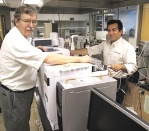MSU to Test Gulf Seafood Using Agilent Technologies' Analyzer
Agilent Technologies Inc. and Mississippi State University (MSU) announced a new analytical method developed by State Chemical Lab scientists at MSU that will be used to test seafood from the Gulf of Mexico for evidence of oil contamination, pending review from the U.S. Food and Drug Administration (FDA).

Agilent service engineer Steve Hite (l) and Agilent gas chromatography special solutions engineer Mario Morales install a GC/MS/MS PAH Analyzer at the Mississippi State Chemical Lab.
Mississippi State University recently received a boost for the new method when Agilent installed a 7000 Series GC/MS/MS PAH Analyzer that determines levels of polycyclic aromatic hydrocarbons (PAHs), the primary oil contaminants that affect seafood. Agilent engineers completed setup of the new instrument the first week of July.
“Repetition and precision in the testing process are essential,” said Associate Professor Kang Xia, who also serves as director for the Research Division and the Industrial and Agricultural Services Division of the Mississippi State Chemical Lab. “The lab’s current instrument isn’t reliable. It is over 10 years old and has suffered numerous mechanical and software failures due to its advanced age and heavy use. Agilent’s 7000 Series GC/MS/MS PAH Analyzer will prevent this from happening.”
In addition, the analyzer shortens the turnaround time between testing a sample and providing results to regulatory agencies. With the new piece of equipment, it will take about two-and-a-half days to take 20 samples, run tests and receive the results. This method takes less time than the method currently used by the National Oceanic and Atmospheric Administration (NOAA), which takes five to six days.
The State Chemical Laboratory expects to submit the new test process to the FDA for review by the end of July. Findings will also be submitted to a peer-reviewed publication.